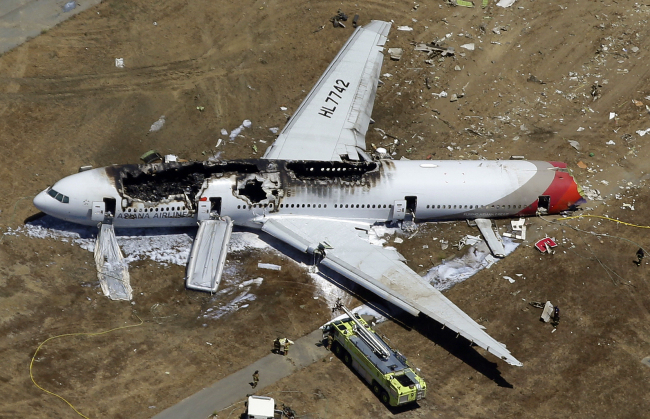NTSB: Asiana crash was caused by pilot error amid over-reliance on automation
By 이현정Published : June 25, 2014 - 08:49
Pilot error was the main cause of a 2013 Asiana passenger jet crash, U.S. investigators concluded Tuesday.
They also warned of the risks from over-reliance on automated systems in the cockpit.
"The flight crew over-relied on automated systems that they did not fully understand," Christopher A. Hart, acting chairman of the National Transportation Safety Board (NTSB), said at a board meeting here. "As a result, they flew the aircraft too low and too slow and collided with the seawall at the end of the runway."
He was referring to the results of the agency's year-long probe into the accident.
The Boeing 777 plane, operated by the South Korean airliner, struck a seawall as it was landing at the San Francisco International Airport on July 6, 2013.
They also warned of the risks from over-reliance on automated systems in the cockpit.
"The flight crew over-relied on automated systems that they did not fully understand," Christopher A. Hart, acting chairman of the National Transportation Safety Board (NTSB), said at a board meeting here. "As a result, they flew the aircraft too low and too slow and collided with the seawall at the end of the runway."
He was referring to the results of the agency's year-long probe into the accident.
The Boeing 777 plane, operated by the South Korean airliner, struck a seawall as it was landing at the San Francisco International Airport on July 6, 2013.

Three Chinese passengers died and more than 180 others on board were injured.
It was the first fatal commercial airliner crash in the U.S. in almost four and a half years.
Hart cited the risks of using automated systems.
"Automation has unquestionably made aviation safer and more efficient. But the more complex automation becomes, the more challenging it is to ensure that the pilots adequately understand it," he said.
In the report, the NTSB said Boeing should have flight training manuals that clearly describe how auto throttle works.
It added the pilots' fatigue seems to have also played a role in the accident. The flight from China via Incheon took more than 10 hours.
The Washington-based agency made a set of safety-related recommendations to the Federal Aviation Administration, Asiana, Boeing and others. (Yonhap)



![[Herald Interview] 'Amid aging population, Korea to invite more young professionals from overseas'](http://res.heraldm.com/phpwas/restmb_idxmake.php?idx=644&simg=/content/image/2024/04/24/20240424050844_0.jpg&u=20240424200058)












![[KH Explains] Korean shipbuilding stocks rally: Real growth or bubble?](http://res.heraldm.com/phpwas/restmb_idxmake.php?idx=652&simg=/content/image/2024/04/25/20240425050656_0.jpg&u=)

